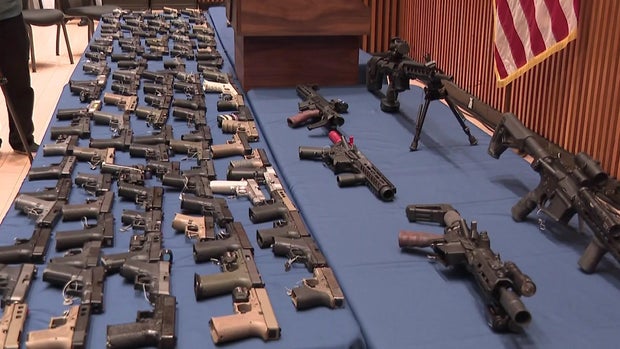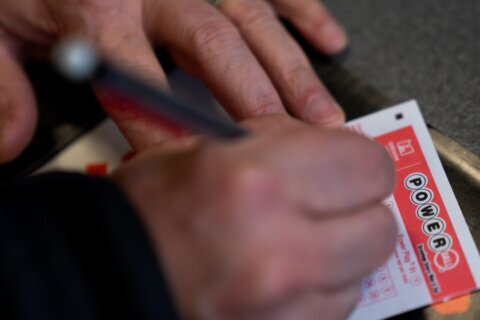▶ Watch Video: ATF director on sweeping report tracking ghost guns
The use of ghost guns — homemade firearms that can be built from parts bought online or with 3D printers — in U.S. crimes has risen more than 1,000% since 2017, the Department of Justice said in a federal report released Wednesday. The findings are based on tracing data collected by the Bureau of Alcohol, Tobacco, Firearms and Explosives (ATF), and present the most comprehensive data in two decades on crime and guns in the U.S.
The collected information provides intelligence into previously unknown patterns in the use of guns and crime.

While there’s no data on how many ghost gun parts are sold, or how many ghost guns exist, the dramatic rise in the use of these privately-made guns in crime provides some insight into the explosive number of such guns in the hands of the American public.
Police-submitted requests to the ATF to trace ghost guns jumped from 1,629 in 2017, to 19,273 in 2021, the report said, while cautioning that this data is most likely grossly underreported.
In total, police submitted 1,922,5771 crime guns to ATF for tracing between 2017 and 2021. Chicago topped the list of cities in which most crime guns were recovered.
This is just the tip of the iceberg, Benjamin Hayes, former ATF special agent and branch manager at the ATF National Tracing Center, told CBS News.
“We continue to produce so many firearms, and they are just pouring into the public domain. The abundance of these firearms and the myriad of environments in which they reside, make it easy for someone with criminal intent to obtain a gun,” he said.
Under new federal rules regulating ghost guns, implemented in August, commercial manufacturers of ghost gun assembly kits are required to include serial numbers. Sellers need to be federally licensed, run background checks before selling a homemade gun kit, and keep records of the purchases for as long as they are in business.
Vice President Kamala Harris, a former prosecutor, noted that ghost guns pose “an especially grave threat to the safety of our communities” because of how easy they are to obtain and how difficult they are to trace, in remarks at the White House in April announcing the regulations.
Ghost guns are just one of the troubling indicators in which the collected information provided insights into previously unidentified patterns in the use of guns and crime.
The data also shows that, often, guns used in crimes have been bought relatively recently. During the five-year reporting period, nearly 25% of the guns traced by ATF after being recovered from crimes had been purchased within the past year, and 46% within three years or less, the report said.
It’s a metric known as “time to crime” — “the length of time between the date of a firearm’s last known purchase (often to the first retail purchaser or, when additional transfer information is available to the last known purchaser) to the date of its recovery by law enforcement as a crime gun,” the report explains.
Richmond, Detroit, and Colombia, South Carolina, were among the cities with shorter average “time to crime” statistics in the report, while New York, Baltimore, and San Jose were among those with longer average “time to crime” statistics, indicating a common pattern, said Daniel Webster, professor and director at the Center for Gun Violence Prevention and Policy at John Hopkins Bloomberg School of Public Health.
“All states with the longest ‘time to crime’ have the strongest gun laws, and generally speaking, the shortest ‘time to crime’ have weakest gun laws,” said Webster.
Most of the “crime guns” traced by ATF were found less than 10 miles from the last known purchaser’s home — even though almost 60% of those guns were used by somebody else in the crime.
More than 90% of crime guns were brought by males, with the biggest age group between 21 and 25 years old, the report said.
These are notable rises in the data not seen in previous years, said Webster, correlating to the massive increase in gun sales since the start of the pandemic.
An estimated 7.5 million Americans became new gun owners from Jan. 1, 2019, to April 26, 2021, according to the 2021 National Firearms Survey.
For the first time in two decades, the report named the manufacturers whose guns had been used in crimes. Glock manufactured 20% of the pistols used in crimes, the ATF report said, and the most common type of gun used in a crime was a 9mm pistol.
ATF used to name dealers who had sold many of the crime guns until the 2003 Tiahrt Amendment to the Justice Department appropriations bill ended that practice.
Providing dealer information alongside gun manufacturer data would be helpful to control the flow of guns used in crimes, Webster said.
“There are profits to be made,” said Webster. “Some notable number of dealers expand the marketplace systemically and routinely, and this is one of the big reasons we have increased gun violence.”






